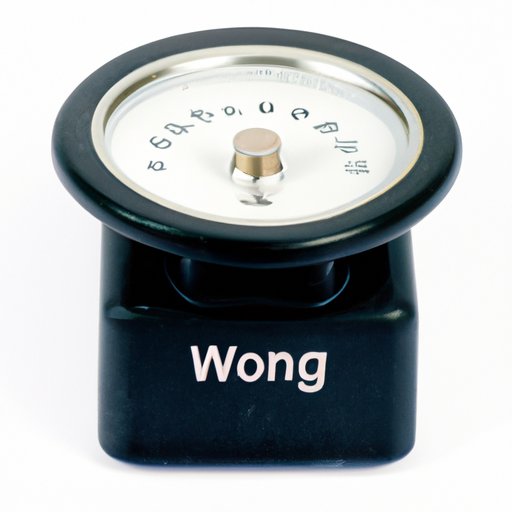
Introduction
Have you ever heard of tare weight? It may not be a term that you’re familiar with, but it’s one that’s incredibly important for a variety of industries and individuals. In this article, we’ll provide an in-depth look at tare weight, its definition, and how it is used. We’ll also explore its importance in various areas, including shipping and transport, food packaging, weight loss, and the environment.
Understanding Tare Weight: A Beginner’s Guide
Tare weight refers to the weight of a container or a vehicle when it is empty or unloaded. It is commonly used in industries such as shipping, where weight limits need to be adhered to, and in food packaging, where the weight of the packaging needs to be subtracted from the total weight to accurately determine the weight of the product.
To determine tare weight, you simply need to weigh the container or vehicle when it is empty. This weight is then subtracted from the total weight to determine the weight of the contents inside.
Tare weight is used in a variety of industries, including shipping, where containers of goods are weighed before being loaded onto a ship. It is also used in food packaging, where the weight of packaging needs to be accurately determined and subtracted from the total weight of the product.
The Importance of Tare Weight in Shipping and Transport
Tare weight plays a critical role in shipping and transport. It allows shipping companies to adhere to weight limits set by laws and regulations, which are in place to ensure safety and prevent accidents. Overloading of goods in containers can lead to instability, which can cause accidents and damage to the products being shipped.
Tare weight also helps to ensure that trucks, trailers, and shipping containers are loaded efficiently and safely. By knowing the weight of the empty vessel, shipping companies can avoid overloading and balance weight distribution, preventing accidents on the road or at the port.
Industries that rely on accurate tare weight measurements include agriculture, construction, automotive, and aerospace. For instance, in the aviation industry, knowing the tare weight of an airplane is crucial to determining how much fuel is needed to power the aircraft, as excess weight can increase fuel consumption and lead to inefficiency.
How to Calculate Tare Weight for Food Packaging
In the food industry, tare weight is used to determine the weight of the product inside the packaging. It ensures that the weight of the packaging is subtracted from the total weight of the product, providing accurate pricing and labeling information for consumers.
To calculate tare weight for food packaging, the empty container’s weight must be measured before adding the product. The container’s weight is labeled on the packaging, and when the product is weighed with the container, this weight is subtracted. This process helps provide transparency in the food industry and ensures that consumers get the right value for their money.
Tare Weight vs Gross Weight: What’s the Difference?
Gross weight refers to the total weight of a vehicle or container, including the weight of the contents and the weight of the vehicle or container itself. Tare weight, on the other hand, only refers to the weight of the empty vessel.
While tare weight is used for various purposes, such as shipping and food packaging, gross weight is commonly used in determining vehicle or container weight limits that need to be adhered to. It is also used in industries such as agriculture to determine the total weight of crops harvested or in waste management to determine the weight of waste produced by a household or organization.
Knowing both tare weight and gross weight is essential in many industries and contexts. For example, in the shipping industry, gross weight is used to determine weight limits, while tare weight is used to ensure that the weight of the empty vessel is subtracted from the total weight of the goods being shipped.
Understanding Tare Weight for Weight Loss
Tare weight plays a critical role in maintaining a healthy diet and losing weight. When measuring food portions, it’s essential to know the weight of the plates and bowls being used to determine accurate serving sizes. By using a food scale that allows for tare weight, individuals can measure food without the need to add extra weight for the containers used, thus providing consistency in portion control.
The relationship between tare weight and calorie counting is significant. In this way, it is vital to understanding weight loss as weights taken from a tare scale can be taken to control calorie intake. By eliminating the margin of an inaccurate estimate that comes from only taking the food into account and not the containers, the results of a diet controlled by tare weights can be more precise.
The Environmental Benefits of Tare Weight
Measuring tare weight can help significantly reduce waste, especially in the ongoing battle against single-use packaging materials. By knowing the weight of the packaging used in products, companies can look for ways to reduce its weight without compromising the safety or functionality of the product.
By reducing the weight of packaging materials, less packaging waste is produced, and fewer resources are used overall. This works to maintain the sustainability of the materials used in packaging and helps reduce waste disposal in landfills and oceans.
Conclusion
Tare weight plays a crucial role in various industries and contexts, from shipping and transport to the food industry, weight loss, and sustainability efforts. By understanding what tare weight is and how it is used, individuals can make more informed decisions about purchasing, portion control, and packaging materials. By reducing the overall weight of containers, shipping firms can improve fuel efficiency and safety while lessening environmental impact.
By using tare weight to manage packages, transportation, food packing, and other applications, as discussed throughout this article, we can each do our part in reducing pollution, make businesses and individuals more cost-effective, and support overall sustainability efforts in industries worldwide.




